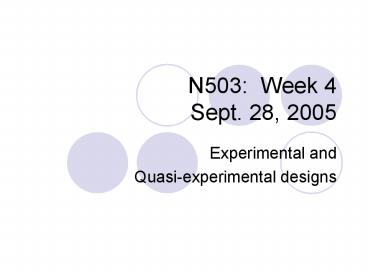N503: Week 4 Sept. 28, 2005 - PowerPoint PPT Presentation
1 / 15
Title:
N503: Week 4 Sept. 28, 2005
Description:
Example 2: Do teenagers who no longer have access to the family vehicle have more tidy bedrooms? 1. Randomly select a group of teenagers (generalizability) ... – PowerPoint PPT presentation
Number of Views:45
Avg rating:3.0/5.0
Title: N503: Week 4 Sept. 28, 2005
1
N503 Week 4Sept. 28, 2005
- Experimental and
- Quasi-experimental designs
2
Essential components of true experimental designs
- Random assignment to groups
- Control of extraneous variables
- Manipulation of the independent variable
- At least two groups.
3
Basic design
- Example
- What is the effect of preop teaching on postop
pain and medication consumption? - Independent variable Preop teaching
- Dependent variables postop pain and medication
consumption
4
Variations on basic design
- More than 1 variation in independent variable.
- Usual preop teaching, structured preop teaching
with lecture, structured preop teaching with
video - More dependent variables
- Patient knowledge, postop pain, medication use
5
After only design
- R X O1
- R C O2
6
Example 1 Among adults, does an apple a day
keep the doctor away?
- 1. Randomly select a group of adults
(generalizability) - 2. Randomly assign a group of people to
experimental or control groups (control) - 3. Give people in the experimental group an
apple each day for 6 months - 4. Count the number of ill episodes for which a
doctor visit was necessary in each group - What is the independent variable?
- What is the dependent variable?
7
Before-After Design
- R O1 X O2
- R O3 C O4
8
Example 2 Do teenagers who no longer have
access to the family vehicle have more tidy
bedrooms?
- 1. Randomly select a group of teenagers
(generalizability) - 2. Randomly assign them to experimental or
control (control) - 3. Assess each student on a tidiness scale by
rating their bedrooms - 4. Give the experimental group an intervention
that consists of removing access to the family
vehicle - 5. Assess tidiness a second time in both groups
- 6. Check whether the students who lost access to
the family car had improved tidiness scores,
compared to students in the control group. - Independent variable?
- Dependent variable?
9
Solomon Four Group Design
- R O1 X O2
- R O3 C O4
- R X O5
- R C O6
10
Example 3 Does the provision of donuts at report
increase alertness in staff nurses?
- Randomly select group of staff nurses
(generalizability) - Randomly assign to one of four groups (control)
- Do assessment of alertness in 1 experimental and
1 control group. - Provide both experimental groups with donuts
prior to the start of report. - Now assess all 4 groups for alertness.
- Compare
- Scores of the after only with the scores of
pre-test groups - Scores of two pretested to each other
- Scores of two after-only groups to each other
- Scores of two experimental groups together to two
control groups - Indpendent variable?
- Dependent variable?
11
Essential components of quasi-experimental designs
- Manipulation of the experimental variable
- No random assignment to groups, and/or
- Extraneous variables added as independent
variables - Homogenous samples
- Matching
- No control groups
- Non-equivalent group designs (comparison group)
- Time series designs (own control)
12
Example 4 Does an apple a day keep the doctor
away? (time series)
- 1. Randomly selected participants
- 2. Randomly assigned to groups
- 3. Apples given to experimental group but some
people didnt like apples and they gave them to
people in the control group. - 4. Retrospectively collected dr. visit data each
month for 4 months prior to provision of apples
and for 4 months following provison of apples.
13
Example 5 Does an apple a day keep the doctor
away? (non-equivalent group)
- 1. Random selection
- 2. Participants from 2 communities
- A. Community 1 is in an apple growing district
- B. Community 2 is in a district with no access
to apples - 3. Assess doctor visits at time point 1
- 4. Assess doctor visits at time point 2
14
Controlling unwanted influences in experimental
and quasi-experimental designs (internal validity)
- Extraneous variables
- Intervening
- Confounding
- Bias
- Hawthorne Effect
- Time
15
Data analysis for quasi-experimental designs
- Non-equivalent group designs
- ANOVA
- ANCOVA
- Time series designs
- Time series analysis (similar to regression)































